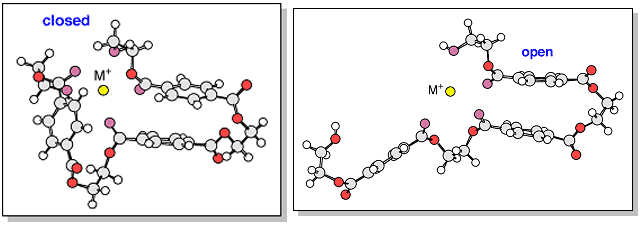|
 Two
families of conformers are predicted for the 3-mer that have similar
energies but differ in cross-section by 18 ± 3 Å2
(see plots at right). In both families, two ET units fold so that the
phenyl groups stack on top of each other and the M+ ion coordinates
to multiple carbonyl and terminal hydroxyl oxygens (shown in purple in
the figures below). In the smaller cross-section family ("closed"
form), the third ET unit folds toward the stacked pair so that the terminal
OH group coordinates to the M+ ion. In the larger cross-section
family ("open" form), the third ET unit extends away from the
stacked pair. The "closed" form is predicted to be the lowest
energy conformer for all three metal cations but the magnitude of the
energy difference between the "closed" and "open"
forms is metal-dependent (5 kcal/mol for Li+, 1 kcal/mol for
Na+, and 2 kcal/mol for K+). Two
families of conformers are predicted for the 3-mer that have similar
energies but differ in cross-section by 18 ± 3 Å2
(see plots at right). In both families, two ET units fold so that the
phenyl groups stack on top of each other and the M+ ion coordinates
to multiple carbonyl and terminal hydroxyl oxygens (shown in purple in
the figures below). In the smaller cross-section family ("closed"
form), the third ET unit folds toward the stacked pair so that the terminal
OH group coordinates to the M+ ion. In the larger cross-section
family ("open" form), the third ET unit extends away from the
stacked pair. The "closed" form is predicted to be the lowest
energy conformer for all three metal cations but the magnitude of the
energy difference between the "closed" and "open"
forms is metal-dependent (5 kcal/mol for Li+, 1 kcal/mol for
Na+, and 2 kcal/mol for K+).
The 300 K ATD for Li+PET3 shows
two peaks, indicating that two conformers are present. The cross-section
obtained from the shorter-time ATD peak agrees with the value predicted
for the "closed" form and the cross-section obtained from the
longer-time ATD peak agrees with the value predicted for the "open"
form (the experimental cross-sections are shown as the red shaded areas
in the scatter plots).
For Na+PET3, only one peak appears
in the 300 K ATD. The resulting experimental cross-section (175 ±
3 Å2) falls between the predicted values of the "closed"
(164 ± 3 Å2) and "open" (182 ±
3 Å2) forms. This raises the possibility that the "closed"
and "open" forms are present but are rapidly isomerizing in
the drift cell, yielding a single, time-averaged ATD peak. If the drift
cell is cooled to 80 K, two peaks appear in the ATD whose cross-sections
differ by 20 ± 2 Å2. This is in good agreement
with the difference predicted for the "closed" and "open"
forms. For a more detailed discussion about the Na+PET3
ATDs see the 3-mer
dynamics section.
For K+PET3, only one peak appears
in the 300 K and 80 K ATDs. The experimental cross-section (169 ±
3 Å2) obtained from the 300 K ATD agrees well with the
calculated values of the "closed" form (168 ± 3 Å2).
The 300 K data for all three metal cations is
summarized in the table (bottom).
|



